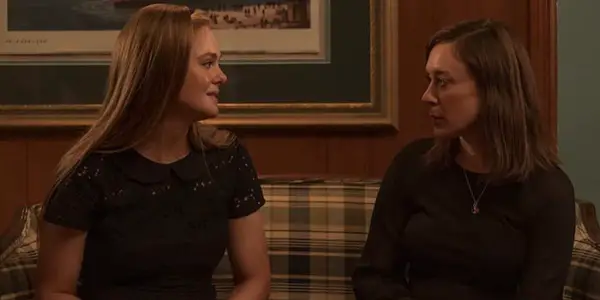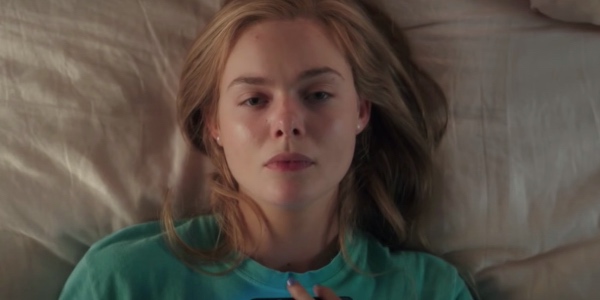THE GIRL FROM PLAINVILLE (S1 E1-3): Modern Crime Drama For The Modern World

Stephanie Archer is 39 year old film fanatic living in…
In Episode 3, “Never Have I Ever”, a character speaks of her lack of envy for today’s teenagers. In a world of technology, with everything on display, every word uttered in a digital world is permanently recorded and stored. A time of “he said, she said” and hearsay face extinction in modern times. We have seen this recently in a growing world of cancel culture, where tweets, Facebook posts, and even shared imagery are plucked from the past and used against one another, whether it be to prove a point, expose wrongdoing or even simply bring someone down. In today’s world, nothing can ever truly be forgotten or erased.
This is at the core of the first three episodes of Hulu’s The Girl from Plainville, a miniseries that looks at the criminal case of Michelle Carter, a teen accused and found guilty of manslaughter in the infamous Texting Suicide case of Conrad Roy. Yet, where everyone may remember her as the girlfriend who texted her boyfriend to kill himself, The Girl from Plainville wants to follow its own episode three advice and look at the whole picture, going at it from different angles and seeing where each piece of the story will ricochet off the other. And while it does find some bumps in the road along the way, this three-episode launch has enough intrigue and even mystery to boast it as binge-able.
Star-Crossed Lovers
The Girl from Plainville opens with two disclaimers, one leaning into artistic interpretation and the other relating to Suicide Prevention – Hulu taking a note from the criticisms of shows like 13 Reasons Why before it. And a good thing too, because The Girl from Plainville does not wait to bring Conrad’s suicide to the audience, making it front and center. It is a clever move on the part of the writers. As viewers, we know what the end result was and why it ignited a seemingly controversial examination into the manslaughter charge brought against Michelle Carter.

From the moment “Star-Crossed Lovers and Things Like That Begins”, we meet Lynn (Chloë Sevigny), Conrad’s mother, as she files a Missing Person’s report to local authorities. She knows the procedure, but knows her son even better, his failure to return home that night worrying. This immediate introduction of Conrad’s suicide is an early indication of the series’ intention to remain nonlinear in its narrative structure, this is confirmed as viewers are given the opportunity to see the first meeting of Conrad (Colton Ryan) and Michelle (Elle Fanning) in Florida in the following episode.
It is an instantly heartbreaking opening to a series that holds the promise to go even darker. There is more to the story than “the girl who texted her boyfriend to kill himself”. These are two individuals who each have their own stories long before their paths ever crossed. As viewers are taken into episode two, “Turtle”, we are welcomed to come to understand and experience a sense of love at first sight, Conrad and Michelle meeting in Florida, and a bike ride turning into an all-day getaway. And as we get a sense of who Conrad and Michelle were in the beginning, we slowly begin to understand who they became in the present, the past and present seemingly running parallel to one another, contrasting and questioning what we thought to be true.
Calculated Manipulation
Yet, while the first three episodes introduce us to the past and present Conrad and Michele, it is Michele that stands out the most. “Star-Crossed Lovers and Things Like That Begins” is uncomfortable, not only in its subject matter but at its core in Michelle. We as viewers either know or suspect she is lying, that her grief is a facade. Yet, as we watch those around her fall for the act, the discomfort rises – whether it be in our uncertainty of the truth or empathy for those she is about to emotionally break. She is overly bubbly at times, and others overly distraught. There is a fakeness to her projection of grief, that at first feels true, but slowly begins to run its course.

As we watch episode two the calculations in the manipulation of Lynn and Conrad’s friends, we see how much power a stranger can have just by claiming how close they were to someone. We begin to see the projection as merely that – a projection. Using emotionally moving clips from popular TV shows, and the guilt that can come with one’s grief, Michelle is able to move others toward her. Friends are guilted into spending time with her, while Conrad’s family – particularly his mother – are forced into a sense of unity and inclusion.
But the ultimate question becomes why – why would she do this? What is her endgame? And that is the hook The Girl from Plainville is counting on. We need to understand why someone would do this, and in the face of behavior seek out an explanation for how someone can become that way. What is her driving force, her motivation?
The Ups and Downs
The Girl from Plainville is not a knockout of the ballpark – and an argument could be made for its existence. Its pacing at times is challenging, the first episode finding a lag in the middle, Michelle’s constant overarching displays of grief and agony feeling drawn out, running its course early on. Yet, as we see a more manipulative side emerge, viewers will find themselves snapped back into the narrative, wanting to know more about Michelle. Episode three also drags, its oversaturation of exposition loses a lot of steam spending time further investing in its central figures while quickly introducing new ones. There is an attempt to give every character a sense of depth and purpose, but the effort at times is to the detriment of the series’ flow.

The nonlinear structure of The Girl from Plainville, like its pacing, finds its ups and downs. As the series begins to toggle between the past and present, episode 2, “Turtle”, finds success in its change of setting, Florida becoming a defining element. For Episode 3, “Never Have I Ever”, this broken timeline becomes hard to decipher. Last year’s Cruel Summer also worked with juggling its past and present timelines, its characters are given a different hue and contrast to help decipher where in time we are – that and the main character’s hair length. Small differences helped to ease the flow of time, something The Girl from Plainville struggles with overall by episode three.
Yet, if there is to be a positive, it’s the performances. Chloë Sevigny and Elle Fanning are undeniable stars, their performances unrelenting, drawing a deep emotional reaction from their audience. Each has its avenues of expression to harness and execute, yet each meets the challenge, every ounce of their performance believable and wrenching in its own way. Sevigny captures the essence of a grieving mother, especially in Lynn’s loneliest moments, the burial of a dead rabbit one to note. Elle Fanning is able to find a deep contrast from her current recognizable role of Catherine the Great in Hulu’s The Great. Gone is the euphoric effervescent spirit, replaced with fake smiles and calculated motives.
Conclusion
There is a deep thoughtful element to The Girl From Plainville, not only in its tackling of teen suicide but in the blissful ignorance of the suffocating nature of today’s technology. We no longer own the words we type, even the words we speak. Video, text, posts, and even shared memes are forever stored in the non-tactile “cloud”. Privacy is a concept known only to the psyche in the sense that we can convince ourselves it is real. “Delete” is never truly a solution either, modern technology ensuring that it is almost always still existent.
Honestly, I can not wait to see the performances of Sevigny and Fanning transform in the coming episodes, as the world turns on Michelle and Lynn is faced with the betrayal of a stranger. There are deeper cuts to be made, and a deeper heartbreak to be experienced. This is not a series looking to sugarcoat what Michelle did, but rather take the time to know the individuals involved and understand how something like this could happen. With artistic interpretation, it finds the perfect balance of suspense, intrigue, and cliffhangers to make you want to come back for more.
Have you see The Girl from Plainville? What did you think? Let us know in the comments below!
The Girl from Plainville premiers on Hulu on March 29, 2022, with new episodes every Tuesday!
Watch The Girl from Plainville
Does content like this matter to you?
Become a Member and support film journalism. Unlock access to all of Film Inquiry`s great articles. Join a community of like-minded readers who are passionate about cinema - get access to our private members Network, give back to independent filmmakers, and more.













